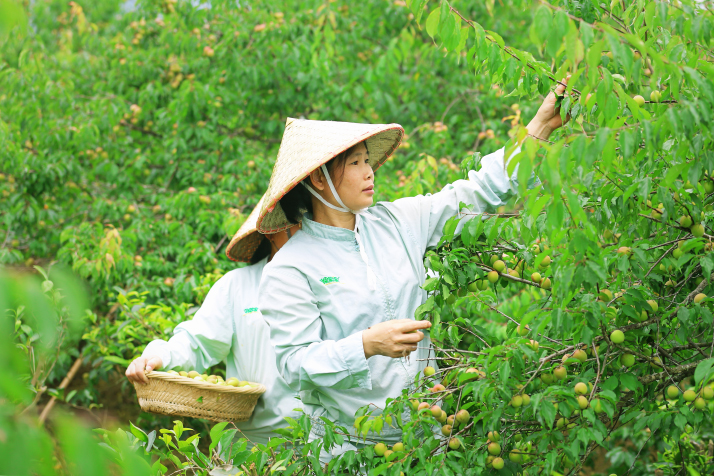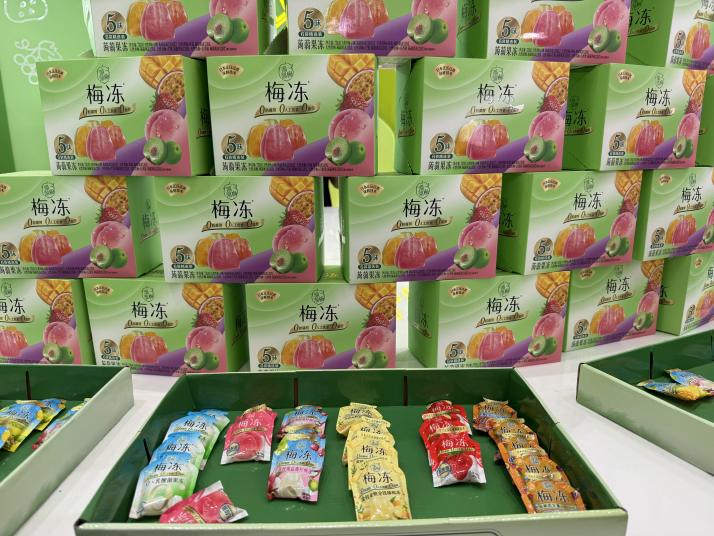| China |
| How a traditional fruit is ripening prosperity in south Anhui | |
|
|
 Farmers pick green plums during harvest season in Wuhu, Anhui Province (COURTESY PHOTO)
Harvested each May, the tart green plums flourishing across south China's orchards have long been treasured as dried snacks or fermented into wines. Now, Anhui Province in east China is writing a new chapter, turning the fruit into an economic boon. Green plums originating from China boast a history of nearly 7,000 years. With over 3,000 years of culinary and medicinal use, the fruit is a treasured ingredient in traditional health practices. With an annual output of 1 million tons, China stands as the world's leading producer of green plums. Based in Wuhu City, Anhui, Liuliu Orchard Group Co. Ltd., a food enterprise founded in 2009, has blossomed into a thriving industry leader. The company's flagship dried green plum snacks, Liuliumei, are nationwide bestsellers and exported to countries including the United States, Australia, Russia and Japan. The company has established itself as a full-cycle green plum producer, managing the entire supply chain, from orchard cultivation to processing and nationwide distribution. It processes around 100,000 tons of plums annually, sourcing from cultivation bases across eight regions in China, including Anhui and Fujian provinces, covering an area of over 20,000 hectares. In 2024, the company's sales revenue totaled 3.8 billion yuan ($530 million). A growing industry Yang Fan, founder of the company, told Beijing Review that he chose Wuhu to set up shop because south Anhui's humid climate is ideal for fruit cultivation. The local government's support for agricultural industrialization has also facilitated the company's growth. In the early days of his venture, Yang noticed that while the green plums grown by farmers in south Anhui were of high quality, their sales channels were limited. This inspired him to delve into the deep processing of green plums. When the company was first established, the team worked in a cramped 20-square-meter office, exploring the market potential in the green plum industry, a niche sector back then. Over the years, Liuliu Orchard has capitalized on the growing demand in the domestic snack market while continuously upgrading its business operations. According to iiMedia Research, an independent market research and data analytics firm, China's snack food industry has seen remarkable growth in recent years. The market is projected to reach more than 1.23 trillion yuan ($172 billion) by 2027, up from 1.17 trillion yuan ($162 billion) in 2022. According to Yang, the company has been making innovation on products and upgrading production lines, with each new offering undergoing one to three years of research and development (R&D) before it's launched. "We've introduced many new products to meet the consumer demand for novel and regional flavors," he said. Beyond its classic preserved plums, the company has also introduced new offerings including plum jelly, plum drinks and black coffee-infused dried prunes. Additionally, in order to diversify its product flavors, it has been importing prunes from the U.S., France and Chile, a country renowned for producing premium-quality prunes. As of this June, it had purchased around 15,000 tons of these dried products from Chile. Driven by health-conscious consumers and stricter regulations, preferences for healthy products are reshaping China's snack market. According to Yang, the dried plum and jelly products are made from natural ingredients, offering healthy alternatives to sugary treats and ensuring no additives, preservatives or artificial coloring. The company has also invested heavily in optimizing production processes. "We have adopted X-ray sorting to ensure pit-free products, and also applied AI technology in sorting green plums and monitoring packaging seals," Yang said. He explained that Liuliu Orchard has introduced fully automated production lines to enable contact-free processing. In the plum jelly workshop, fruit pulp undergoes sterilization and mixing before being transported via vacuum pipes. Robotic arms then handle filling, packaging and boxing—achieving 99-percent operational automation. Currently, the company operates 10 plum jelly production lines, with an annual output value of 1 billion yuan ($139 million) in recent years.  Plum jelly products on display at food company Liuliu Orchard in Wuhu on July 4 (LI XIAOYANG)
Sour, but packing sweet success After signing purchase agreements with local farmers in Fanchang District, where the company is located, Liuliu Orchard has been providing them with seeds and training, as well as purchases their green plums at a price of around 10 yuan ($1.3) per kg. The sales have improved the per-capita annual income of local farmers by 10,000 yuan ($1,390). Yang added that the company manages green plum cultivation to guarantee pesticide-free harvests. By purchasing fresh fruits directly from growers and eliminating middlemen, it also protects the latter from market fluctuations while ensuring reliable raw material supplies. Today, green plum farming has become an economic pillar for Fanchang. The growing area of the fruit in the district has exceeded 1,300 hectares, with the industry's annual revenue totaling nearly 20 billion yuan ($2.78 billion). "We aim to expand cultivation by over 600 hectares, support 1 million rural households and drive the entire industry chain value up toward 100 billion yuan ($13.9 billion)," Yang said. Pu Siting, Deputy Mayor of Fanchang, told Beijing Review that the local government has stepped up support for green plum cultivation, channeling 10 million yuan ($1.3 million) into the industry annually. It has also established a technical team, assisting enterprises in improving green plum varieties and exploring the fruits' medicinal value. According to the district's agricultural bureau, it encourages farmers to grow green plums on barren hillsides and transform low-yield economic forests into plum orchards to improve their income through high value-added plum products. Leisure tourism in plum orchards also brings in additional revenue. Xu Jinfa, a local farmer, started growing green plums on a 2-hectare barren land in 2017. Each tree could produce around 50 kg of green plums every year, and the total net profits are expected to reach around 70,000 yuan ($9,747) in 2025. To date, the local government of Fanchang has invested over 30 million yuan ($4 million) in infrastructure and subsidies for plum cultivation, creating 12,000 jobs for farmers. Plum wine, a traditional beverage in China, is also turning into an economic pillar for locals. In 2023, Xidi Township, a major plum growing area in Huangshan City of Anhui, established an 80-hectare green plum orchard, with an annual output of over 2.5 tons. Fresh green plums are transformed into liquor there, adding 3,000 yuan ($418) to each plum-farming household's annual income. Local agricultural authorities have teamed up with winemakers to establish automated production lines for plum wine processing. With an annual capacity of 1,000 tons, the production lines receive orders with a combined worth of over 30 million yuan ($4.18 million) annually. Through this partnership, Xidi has launched over a dozen products, including fermented plum liquor, plum juice and plum-based dishes. It is also diversifying into study tours, agritourism and live-commerce, a combination of livestreaming and e-commerce, to boost rural incomes. BR (Reporting from Wuhu, Anhui Province) (Print Edition Title: A Plum(p) Deal) Copyedited by Elsbeth van Paridon Comments to lixiaoyang@cicgamericas.com |
|
||||||||||||||||||||||||||||||
|